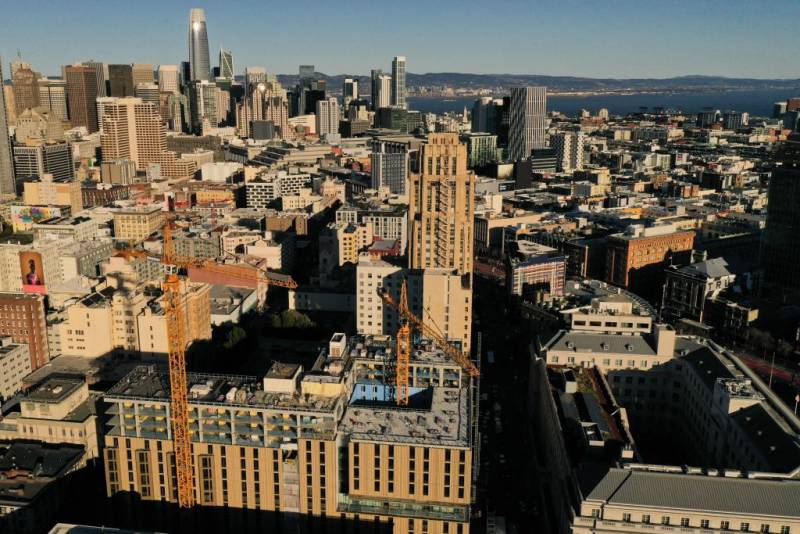“So I think we will see some retrofits coming in the near future, like five to 10 years,” he said. “It’s going to be 10, 15 years for the entire program, we think, to be completed. And those are all really still estimates.”
Identifying which buildings need to be retrofitted, Strong added, is often not easy.
“Some of it has to do with the date when it was constructed, but often it has to do with how much steel they put into the concrete,” he said, noting the limited capacity of the city’s engineers to get the work done. “And that can be very difficult to ascertain. You have to drill into some of these concrete beams and posts and you look at how much steel is in there.”
Benson Shing, professor of structural engineering at UC San Diego, said many of the collapsed buildings shown in photos from Turkey were clearly non-ductile concrete, based on the visible rebar sticking out from destroyed columns and the way in which they crumbled.
“I would say that if buildings had been designed according to the current code, with such a large severe earthquake, probably they would suffer some moderate to severe damage, but it should prevent collapse,” he said.
Turkey, no stranger to large earthquakes, launched a concerted effort last year to rebuild older vulnerable structures, but many building owners were hesitant or unable to begin the costly process.
“A big problem in places like the Bay Area and in Los Angeles in a future earthquake will be [the thousands of] older concrete buildings that have never been inspected and reevaluated in order to be strengthened,” Rong-Gong Lin II, a Los Angeles Times reporter, who has written extensively on earthquake safety, told KQED.
In a 1991 report on the 6.9-magnitude Loma Prieta earthquake that hit the Bay Area in 1989, Stephen A. Mahin, a UC Berkeley civil engineering professor, noted that most non-ductile concrete buildings survived the earthquake, though some were severely damaged, including Peralta Hospital in Oakland, which had to be demolished.
“The thing is that the 1989 earthquake up in the Bay Area — that was actually in the Santa Cruz Mountains,” Lin noted. “So the core Bay Area like San Francisco, Oakland, even San José you could argue, hasn’t really been tested with a pretty significant earthquake directly underneath the urban center since more than 100 years ago.”
Lin pointed out that officials have known about the concrete construction flaws of many older buildings for more than 50 years, since the 6.6-magnitude San Fernando/Sylmar earthquake in Los Angeles killed 64 people, 49 of whom died after the collapse of the San Fernando Veterans Administration Hospital.
“What we found out in 1971 about the configuration of steel that was required at that time [was that] when shaken, concrete is allowed to explode out of the columns,” he said.
Along the lines of what San Francisco is working on, Lin said more cities near fault zones need to urgently “order up a list of these buildings and make that public,” to raise awareness and mandate that they be retrofitted within a reasonable timeline.
But even after identifying the structures, the challenges of retrofitting are considerable, noted Lucy Jones, research associate with Caltech’s Seismological Laboratory.
“Identifying the problem does not make the buildings disappear,” she said. “You have to find the political will to mandate people spending money on their own property by government. That’s not something that’s easy to get through politically.”
But Strong, from San Francisco, said he believes most owners of older concrete buildings in the city do want to retrofit their buildings. He noted the success of the city’s previous retrofit initiatives since Loma Prieta, including one aimed at reinforcing most of the city’s brick structures and another to shore up some 5,000 smaller multistory buildings, often with ground-level commercial spaces — known as soft story buildings.
“They want to do it. A lot of it is just clarity as to what are the expectations and when do I have to do them,” he said. “We know it will be expensive. And it can also be very complicated if we have to relocate businesses that are in the buildings and then bring them back.”
Despite the urgency of getting projects started before the next big one hits, Strong cautioned that such a monumental citywide undertaking needed to be done methodically, and with a focus on equity, to ensure the most vulnerable populations get the assistance they need.
“So we want to make sure that we're doing it in a way that gives people time,” he said. “We believe that rushing into a program means that we won't be as thoughtful, and won’t take all of those things into consideration.”
KQED’s Attila Pelit and Rachel Vasquez contributed reporting to this story.

